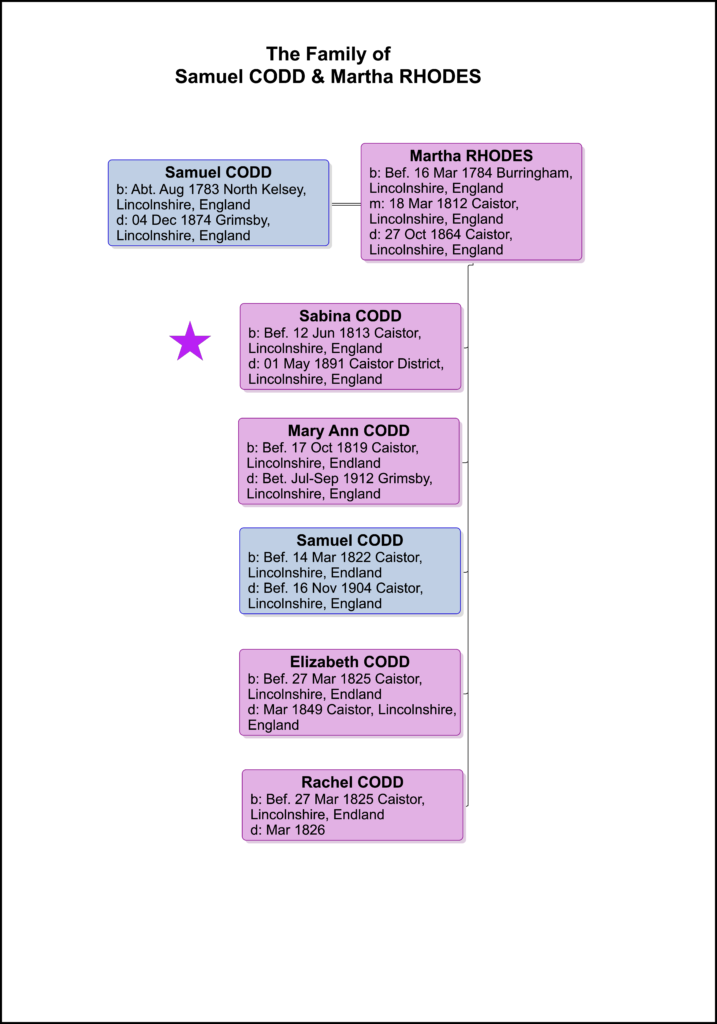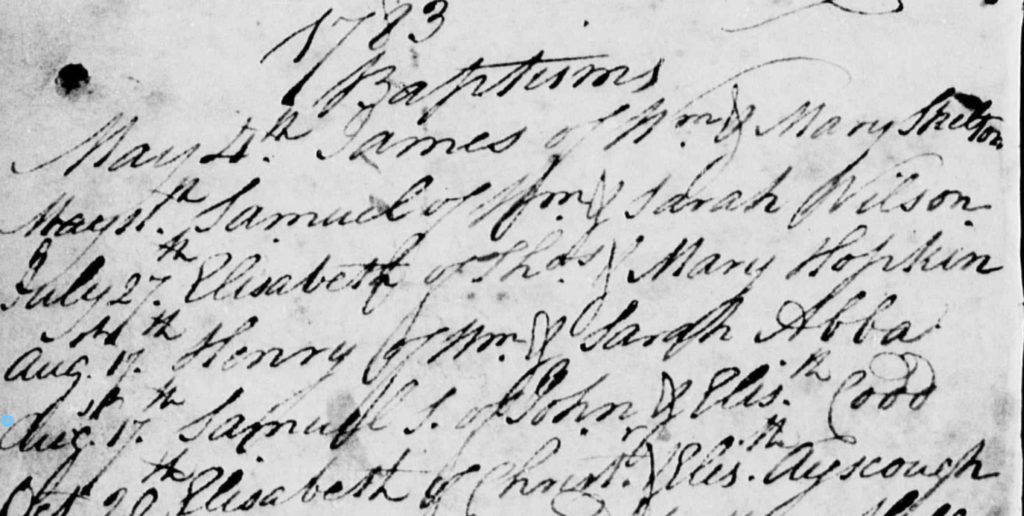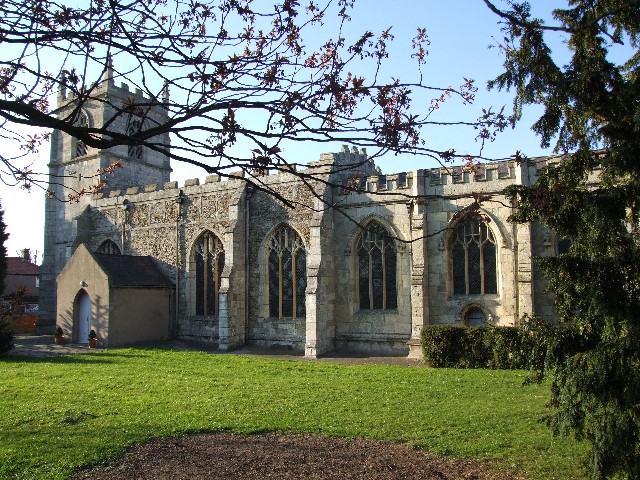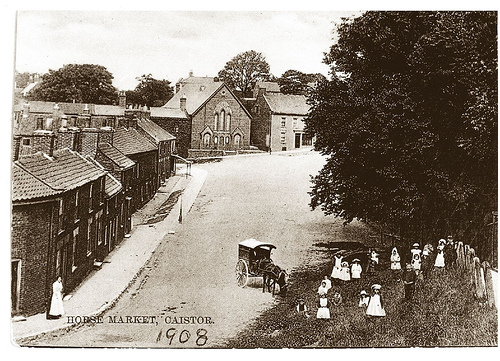The Great-Grandparents of George Alfred Johnson

Samuel CODD
In the small village of North Kelsey in northern Lincolnshire, Samuel Codd was born to John Codd and Elizabeth Hall in about 1783. North Kelsey was a rural village that sat on the River Ancholme and was about six kilometres west of Caistor and ten kilometres southeast of Brigg. Samuel was christened in St Nicholas Church of England, which was built during the 13th century. The original tower still stands today.

Martha RHODES
For many years mystery surrounded the marriage of Alf’s great-grandparents, Samuel Codd and his wife Martha and perhaps, it still does. It is recorded their daughter Sabina was baptised at All Hallows, Clixby in 1813, and from this, we were able to see who her parents were. She appeared to be the first child born to Samuel and Martha. I looked for a Samuel Codd marrying a Martha before 1813 when Sabina was christened. I could not find any. At this time, I did not have a subscription to findmypast.com, but also many of the parish records had not been scanned. I corresponded with a genealogist in Lincolnshire, Rex Johnson (no relation that we know of), and he could not find any in the North or South Kelsey area. He then looked further afield and found the only Samuel Codd marrying a Martha was to Martha Rhodes at Caistor. However, this marriage did not take place until 1829. Samuel would have been aged 45 years and Martha aged 44 years.
For many years I believed this was the marriage. This marriage corresponded with many other people’s family trees on Genes Reunited and ancestry.com.
And also, according to the 1861 census, Martha Codd was born in Burringham, the same place where a Martha Rhodes was born and in the same year. Her parents were Richard and Mary and Martha was christened in 1784 at St Oswald’s church of England, in Althorpe. Althorpe is across the river Trent from Burringham.


The original St Oswald’s was built around 1185 and had links with the Knights Templar and the prestigious Mowbray Family who owned land across the Isle of Axholme. In the fifteenth century the original church was taken down and completely rebuilt by Sir John Neville. It is one of several churches dedicated to the Saint – a seventh century Christian king of Northumberland who was killed in 642AD by the King of Mercia. Oswald controlled the kingdom of Lindsay, a territory very similar to the modern-day county of Lincolnshire. This church was built in the Perpendicular style during the late stage of English Gothic architecture and characterised by broad arches, elaborate fan vaulting, and large windows with vertical tracery.
Marriage
I wondered why Samuel and Martha did not marry until 1829 as mentioned above. They not only had Sabina in 1813 but at least four other children – Mary Ann baptised in 1819; Samuel (I will refer to him as Jnr. in future) in 1822; and Elizabeth and Rachel both baptised in 1825. All were christened at St. Peter and St. Paul’s Church of England, Caistor.
However, perhaps the mystery has been solved. On looking on findmypast.com in the parish records, I found a marriage for a ‘Sammuell Codd and Martha Hoades’. But the scan of the original parish record shows the ‘Hoades’ could be ‘Rhodes”. This Samuel and Martha were married at Alkborough, which is a small town about 17 kilometres north of Burringham and also on the River Trent.
This marriage was on the 18th March, 1812, and, with Sabina being baptised in 1813, it makes more sense that this is the right Samuel Codd and Martha Rhodes. Samuel would have been about 29 years old and Martha about 28 years old.
To find further reference to the lives of Samuel and Martha, I turn to the England Censuses taken in the first year of each decade eg. 1841, 1851 etc. This gives just a little insight into where they lived and their occupation.
We can assume that Samuel and Martha lived in Caistor most of their lives with their children being born there and all baptised at St. Peter and St. Paul’s Church of England. Samuel’s main occupation was most probably a farm labourer or farmer as mentioned on Sabina’s baptism record.
An occupation often referred to in the census is agricultural labourer. Agricultural labourers or farm servants often lived in the small villages and went to work in the farmer’s fields during the day. They worked long hours during the summer months, often from 4.00am to 8.00pm. And during the winter months, they often found they could go for days or weeks without work. They were often hired on Martinmas Day which is the time when autumn wheat seeding was completed in early November. Towns often had hiring fairs where farm labourers could seek new posts. Some of the larger farms had their own cottages but most hired their labourers from the surrounding villages.
Caistor in 1839 was quite a progressive country town, having grown from the Roman times when it was once a fort. Only a few fragments of the fourth century walls remain, for example; the original Roman wall is visible on the southern boundary of the Church of St. Peter and St. Paul. The town centre consisted of a street pattern based on a series of interconnecting squares – Market Square; Butter Square; Cornhill and Horse Market. The town had a sheep and cattle market on Saturday. Caistor was also well-supplied with water from four springs.
By 1851, Samuel was residing at Nettleton Road and he had changed his occupation to a coal merchant. Why he had changed from labouring in the fields to coal merchant is another question. Perhaps he could not be hired anymore for agricultural labouring as he was now 69 years old and the work was too hard. A coal merchant usually sold coal from a horse and cart, house to house and he may have found this easier. His son Samuel Jnr., who was an agricultural labourer, and his new wife Hannah were staying with him.
On the 30 March, the day of the 1851 census, Martha was visiting with a Thomas and Harriett Johnson at 7 High Street. Thomas was a coach maker and Harriett’s maiden name was Rhodes, Perhaps she was related to Martha – a niece? Or perhaps Thomas was related to Martha’s son-in-law John Johnson, although I could not find this.
1861

Samuel and Martha continued living in Caistor shifting a few blocks from Nettleton Road to Horse Market.
By 1861 Samuel and Martha are getting on in age but this does not mean they stopped working. In those days, people didn’t retire unless you were very wealthy. Samuel is back to labouring but this is possibly with any odd job he can find and not on contract in the fields. Martha is a laundress, possibly going to wealthier homes to do the washing there or taking in washing and doing it in their own home. All their family had left home and were married themselves and raising families. However, they did have a young lodger staying with them, no doubt helping with their income. He was a Charles Lusby aged 22 years and born in Walesby and was a joiner by trade.
Martha died in 1864 and was buried on the 27th October. She had lived to a good age for people in those days, dying after 81 years. However, I find that many of our ancestors did, perhaps it was in the genes. There was a death notice for Martha in the Lincolnshire Chronicle..

1871
Samuel continued living for another 10 years. By 1871 he had moved to Sanderson’s Yard and was doing a bit of labouring and agricultural work. Joseph Sanderson, who was a builder and landowner, lived at Sanderson’s Row next door to Sanderson’s yard. Perhaps Samuel was living in quarters rented out by Joseph Sanderson and possibly even working for him.
Between 1871 and 1874, Samuel moved to the large town of Grimsby, a seaport, which is situated near the mouth of the Humber estuary. He possibly moved here because of his age being in his early nineties or maybe because of ill-health. He no doubt moved to live with his daughter Mary Ann.
Samuel died on the 4th December, 1874 and his death was noted in the Lincolnshire Chronicle.

Children
Sabina, the oldest child, married John Johnson and they have their own story.
Mary Ann married Thomas Johnson (no relation that we know of), a farm labourer and local preacher and lived in Swallow before shifting to Great Grimsby. They had 3 children. I am not sure when Thomas died but he disappeared from the census between 1871 and 1881. Mary Ann lived with her daughter Louisa and her family from 1881 until after 1911 in Grimsby. She died in 1912 aged 94 years.
Samuel (jnr.), the first or was he the second son, married Hannah Whatham in 1851. He was a coal merchant like his father before going back to labouring. Samuel and Hannah lived in Nettleton Road for many years – living with his parents and, perhaps staying in the same house when his parents left. Between 1891 and 1901, they shifted to Whitegate Hill, Caistor where Samuel died in November, 1904.
Elizabeth married Thomas Locking, a miller, in 1848. Sadly, Elizabeth died a year later in March 1849.

And Rachel died as an infant in 1826 aged 1 year.
There was a baby, Joseph CODD, who had the parents Samuel and Martha. He was born in 1814 and died in 1816 and was buried in Caistor on October 10th. However, I could not find any baptism records in the registers. Usually, in those days, the eldest male child was named after the father or one of the grandfathers. But we do not have a Joseph in either the father or grandfathers. Also, if a child died, the next male child often carried on with that name. However, as we know with the name Sabina, Samuel and Martha were not known to follow tradition. So, I am not sure if this Joseph is their child or another Samuel and Martha’s. I leave this here for future research.
